How to Build Quality Links From Resource Pages
Every website needs to prioritize link building. Regardless of your business type or industry, backlinks help drive more traffic to your website and are great for SEO purposes.
So where should you start?
Resource pages need to be a major component of your link building strategy. In fact, 56% of webmasters say that they use resource pages to build backlinks.
This strategy is second only to content creation in terms of the most popular ways to build links. Why is this case?
That’s because the sole purpose of resource pages is to link out to other websites, which makes this an easy process. All you need to do is find authority resource pages that are related to your site, and then convince the webmasters to add your site to their page.
It’s actually not that complex when you know how to approach it.
I’ve dealt with so many website owners who have identified the need for building quality links, but they just don’t know how to do it. That was my inspiration for this guide.
I’ll show you the best ways to build quality links specifically from resource pages.
Find relevant resource pages
This needs to be your first step. You can’t just sit back and hope that your website will get picked up by resource pages. That type of passive strategy won’t be effective.
Instead, you need to start researching resource pages that are related to your brand. Narrow down the ones within your niche.
You don’t need any fancy software or subscriptions to do this. All you have to do is use Google.
For example, let’s say your website is in the food industry. You could try the following search string to identify resource pages.
“Cooking” + inurl:links
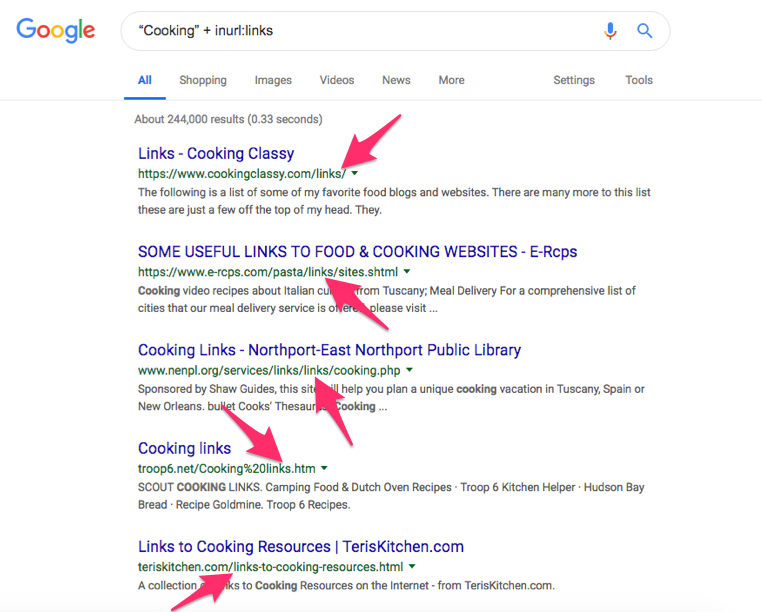
Put your keyword in quotes to find pages related to that specific word, which is “cooking” in this instance. By adding “inurl:links” to the query, it limits the search to websites with the word “links” in the URL.
It’s unlikely that people who have cooking websites will be discussing links. So you know that your search results will yield resource pages.
Generally, everything you see in these SERPs will be a list of links in some form or another. Now you just have to go through each site and select the ones you want to pursue.
Be selective. You don’t need to reach out to every resource page on the planet.
When you’re reviewing the search results, the number one thing to look for is page authority. Page authority is more important than domain authority in this case. That’s because you’re trying to get your link shared on a particular resource page.
So even if certain sites don’t have the highest domain authority, you can still reach out to them if they have a resource page in your niche with a high page authority.
Contact the webmasters
Once you’ve found some resource pages with a high page authority that are relevant to your brand, it’s time for you to reach out to those webmasters.
But before you do that, it’s important to take the time to review the links that are already shared on each particular resource page. This will help you figure out what types of links you should be sending to the webmaster.
In my experience, it’s usually rare for resource pages to link out to the homepages of other websites. When they do link to homepages, it’s usually for bigger and more well-known brands.
So if you’re just blindly submitting your homepage to resource pages, there is no guarantee that you’ll be featured. Instead, you’re better off sending them content pages.
Each webmaster is different, so just make sure you can pitch something that fits within the page you’re requesting a link on. For example, let’s say you found a cooking website that’s mostly related to grilling and BBQ. You could pitch a blog post about a barbeque grilled chicken recipe.
If you don’t have this type of content on your website, you should create it. Not only will it help you get featured on more niche resource pages for the purpose of building backlinks, but it’s also valuable content for your website and SEO strategy.
Take a look at this example from Teri’s Kitchen, which was one of the top hits of the Google search results we saw earlier.

Based on this, it’s clear that the site accepts submissions. In fact, it almost seems like they encourage it.
So in this case, all you’d need to do is reach out. This is something that you’ll see on most resource pages. They’ll be some type of easy contact form or instructions asking for links.
Most resource pages want more links on their site. Remember, that’s the whole purpose of a resource page.
So if you pitch them something relevant, it shouldn’t be too difficult to get featured. It benefits both parties. You build backlinks while the resource page improves at the same time. The more resources these webmasters have on each page, the more valuable it is for their website.
Your pitch doesn’t need to be too persuasive. Less is more. Just send the link with a couple of sentences about why you think it fits on their page.
Alternative search strings
Link building with resource pages is pretty straightforward. As I’ve described above, the whole process can essentially be broken down into two steps:
- Find a relevant page
- Contact the webmaster
By following the search string that we used earlier with “keyword” + inurl:links, it will bring you straight to resource pages.
But to get the most out of this strategy, you need to switch up your search queries to find other results. Depending on your search, you’ll be able to identify different resource pages.
I’ll take you through three of the best search options to improve the first step of this process.
Useful resources
Another one of my favorite search strings for finding resource pages is by adding “useful resources” in addition to the keyword in quotes. Here’s what it looks like using our cooking example:
“Cooking” + useful resources
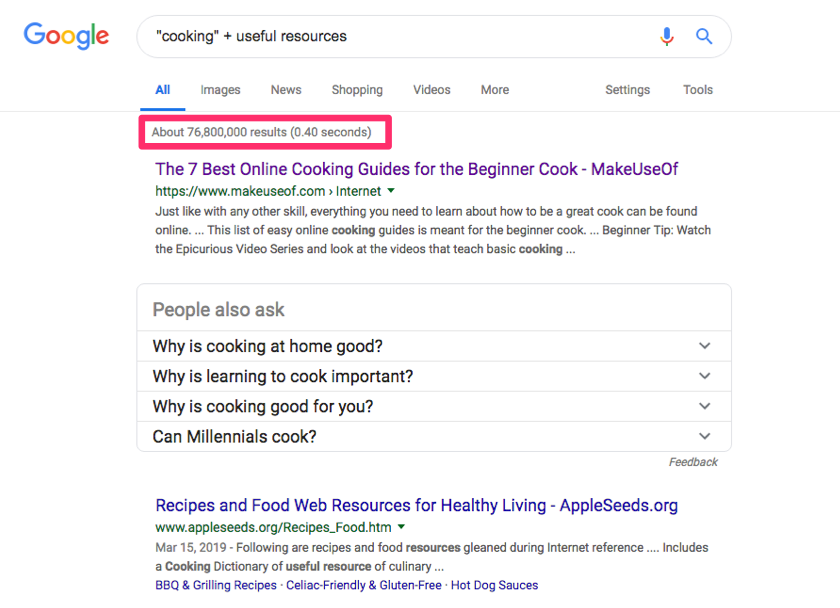
Right away, look at the number of results that this search yielded.
There are nearly 77 million hits. If you refer back to the “inurl” search we used earlier, there were just 244,000 results.
Obviously, you aren’t going to be scrolling through thousands or millions of results. But the point I’m trying to make here is that this alternate search will bring up new results.
In my experience, searching for the keyword plus useful resources usually displays lots of authoritative websites.
Now you just have to follow the same process. Go through each of the top results one at a time. See what kind of content each resource page is sharing. Then determine what link on your site that you’re going to pitch before you contact the webmaster.
In some cases, it can be a bit challenging to get featured on these authoritative sites. They may have a more exclusive selection process. But at the end of the day, they still exist for the same purpose of linking out to other websites, so don’t sell yourself short.
Educational domains
Depending on the type of website you have, you might want to limit your resource page outreach to authoritative and trusted sites only.
For this purpose, I’d recommend using the following search string:
site: .edu “keyword” links
So continuing with our cooking example, the search would look like this:
site: .edu “cooking” links
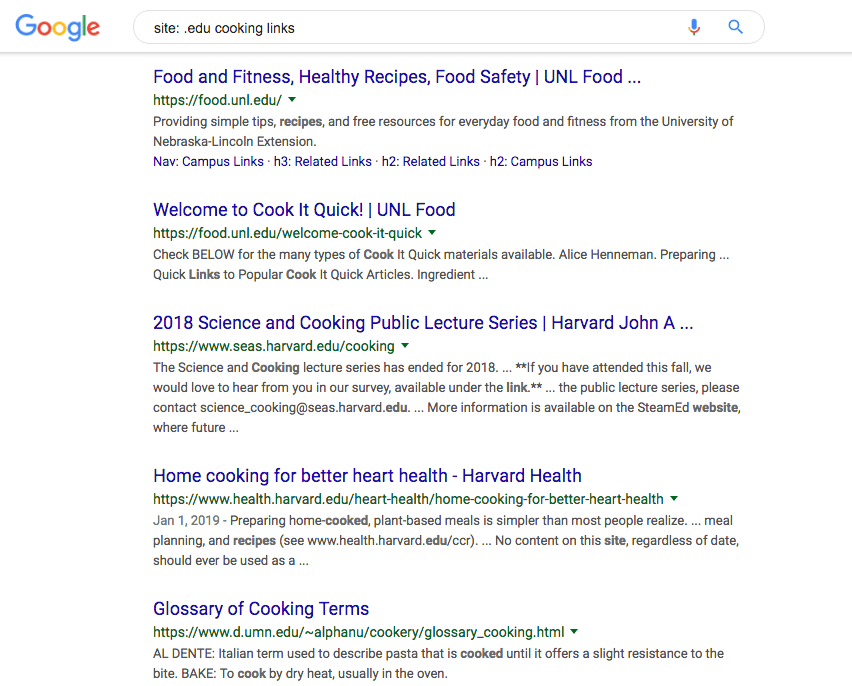
Again, this query will bring up a completely new set of results.
Now, it’s worth noting that not all of the results will necessarily be relevant to your site. You still have to go through and find the ones that are resource pages that are actually accepting submissions.
For the most part, you won’t see sites with a .edu domain that have something like Teri’s Kitchen, which we discussed earlier. Teri asks for submissions right at the top of the page. That won’t be the case for Harvard’s website.
So you’ll need to work a little bit harder to get featured.
Authority sites with .edu domains usually have a big staff as well. It’s not just one person monitoring the site and adding content. General submissions may not always be sent to the right person. So you need to figure out who is responsible for the particular page that you want to be featured on.
Here’s a trick that I’ve used in the past.
Look to the URL of the page. That can give you a clue of who you should be getting in contact with. The URL might give away the particular department associated with that resource page. Then you can go through the staff listing and see who is the head of that department. Their contact information should be available there as well.
You can also use an employee directory or even LinkedIn to find the right person who manages that page or the webmaster for a particular department.
Here’s another trick. Scroll to the very bottom of the page and it will sometimes show you a “last updated by” note with a person’s name.
If you search around on the site and do some digging, you can usually find what you’re looking for. Here’s an example from the University of Nebraska – Lincoln, which was one of the top search results for our .edu query.
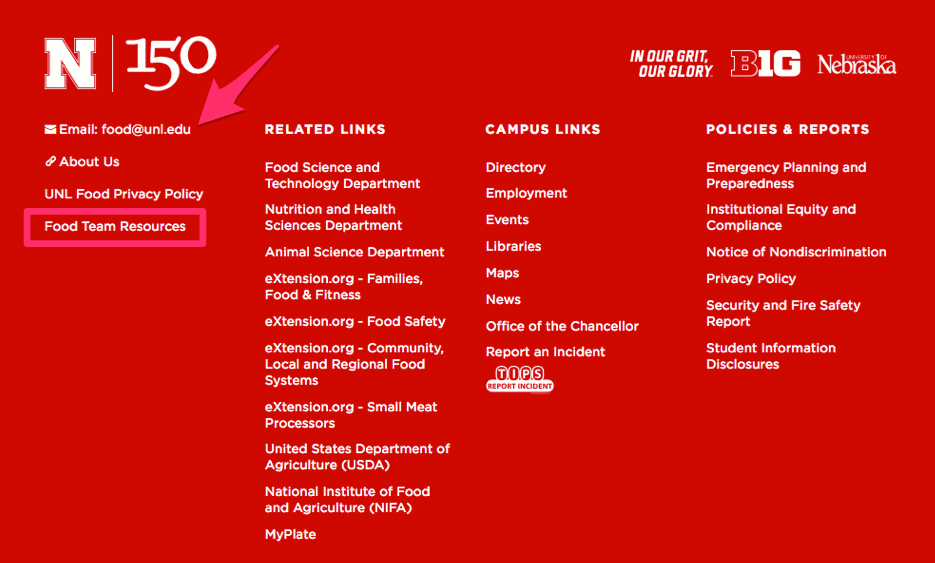
Here is the footer of the resource page.
As you can see, there is a separate email address for the food department.
You could even take this one step further by clicking the “food team resources” link just a few lines below that email address on the left side of the footer.
That would bring you to this page:
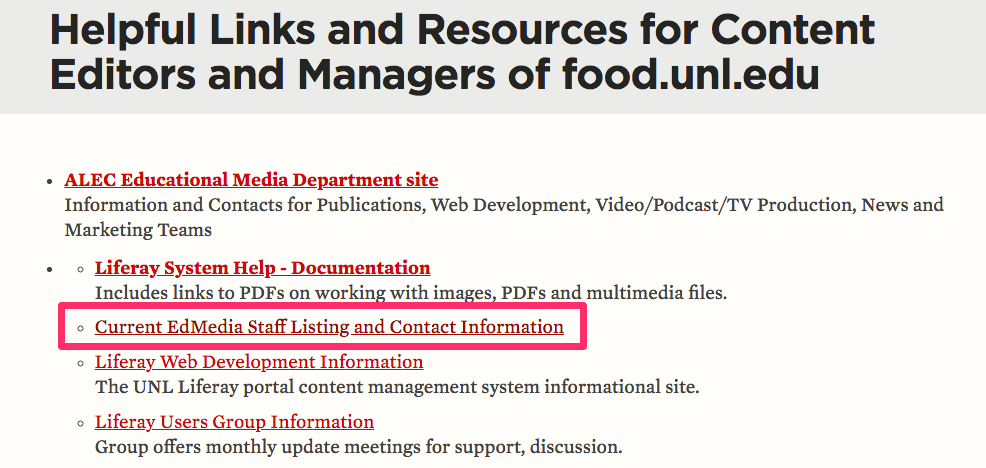
There’s another link here showing the staff listing and their contact information.
It’s better to take these extra steps now to increase the chances of getting your links featured. Otherwise, it’s just going to be a waste of your time if you submit to the wrong person, department, or your submission gets ignored.
Sending emails to info@unviersityabc.edu won’t get the job done. Your message will just get lost in the shuffle.
These websites have so many other things that are more important to deal with. So if your email is delivered to the wrong person, it’s unlikely that they will forward it to the appropriate party.
Related to keyword
If you have a unique niche that doesn’t have tons of resource pages, you’ll need to find ways to broaden your search to get the best results.
Change the search string accordingly. Here is one of my favorite tricks to find more related sites.
Simply remove the quotes from your keyword. By removing the quotes, it tells Google that you’re not looking for an exact match keyword. Years ago you used to have to add a tilde (~) to search for related terms, but now Google does this by default.
So go back and remove the quotes from your inurl, useful resources, and .edu searches to see what comes up.
Here’s an example to show you the difference.

When we first searched for useful resources with quotes around cooking, we got just under 77 million results.
But now that we’ve removed the quotes, we’re approaching 92 million hits.
Conclusion
Resource pages should be at the top of your priority list when it comes to your link building strategy.
Take advantage of all of the different search strings that I’ve explained above. This will give you the widest range of search results to find resource pages in different categories.
I’d recommend going through the top 50 hits or so within your niche for each query. Then narrow down the options that would be a good fit for your site.
Now find your best content that matches the specified resource page before you ask to be featured. Remember, it’s more likely that your link will be shared if you pitch content as opposed to the general homepage.
Make sure you contact the right person. This will be more challenging for higher authority sites, especially with an .edu domain, but it’s still doable if you dig around.
If you don’t have content that fits these resource sites, you can always create new content before submitting.
Follow the process that I’ve outlined above to build quality links with resource pages.
COntributer : Quick Sprout http://bit.ly/2Zjg2Jb
 Reviewed by mimisabreena
on
Saturday, April 20, 2019
Rating:
Reviewed by mimisabreena
on
Saturday, April 20, 2019
Rating:















No comments:
Post a Comment